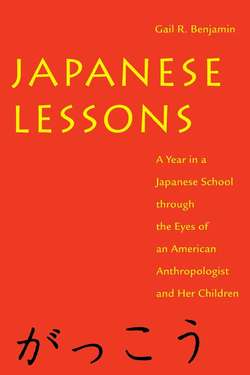Читать книгу Japanese Lessons - Gail R. Benjamin - Страница 9
На сайте Литреса книга снята с продажи.
ENROLLING IN SCHOOL
ОглавлениеEven though our research prospects seemed ideal, even though our housing situation seemed good, even though we felt comfortable making our way around Urawa, and even though we liked our neighborhood and felt confident the year was going to be a good one, we were still a bit apprehensive about school. Would we find that the congenial friendliness of preschool in Japan had given way to a regimented and strictly academic atmosphere, as suggested in some American media depictions of Japanese schools? Would the social pressure for conformity prove to be stronger than in American schools and uncomfortable for foreigners? Just the process of getting our children enrolled and ready for their first day of school provided answers to some of these questions and brought us face to face with differences in approaches to education that became clearer as the school year passed.
Almost immediately after moving into our apartment at Saitama University, we went to Urawa City Hall to apply for our Alien Registration cards. (Sam and Ellen like the term aliens better than foreigners, though not all foreigners feel that way.) With the help of a colleague from the university we were able to arrange a meeting with the city board of education officers responsible for enrolling children on the same day we picked up the Alien Registration cards. We were surprised that such a high-level meeting would be required. Our colleague went with the four of us to this meeting. The principal of the school was present along with two or three officials from the board of education.
The discussion covered several points of concern. The principal and the officials stressed that our children would be expected to participate fully, as Japanese children do. We were warned that no instruction in Japanese as a foreign language would be provided, that they followed the total immersion, “throw them in and see if they swim” philosophy of language learning. The principal said he would, however, assign a few children to guide ours around, play with them, and help them get started. Everyone looked relieved on hearing that Sam had been to preschool in Japan and seemed to think this would make things easier for us and for them, a feeling we shared.
Japanese are always very concerned that Japanese food is so unique that foreigners will find it inedible, and these officials said our children would have to eat the school lunches—as though they felt this might be a major problem. They did ask if there were foods our children couldn’t eat; they recognize that some children have allergies, and many of the Southeast Asian children in this school are Moslems who do not eat pork or some of the seafood found in Japanese school lunches, but our children had no restrictions.
The next part of the discussion centered on the grades in which the children would be placed. In Japan the school year runs from April 1 of each year to the following March. The rules about grade placement are rigidly followed: a child must be six years old by April 1 to begin first grade and must begin on the April 1 following the sixth birthday. Sam, born in April, had just finished fifth grade in the United States, and Ellen, born in March, had just finished first grade. The correct grade placement for Sam was thus fifth grade in Japan. The principal and the officials felt this was the best placement for him. We agreed, and we had discussed this possibility with him beforehand. We knew that much of the material covered would be different from the curriculum at home and that any repetition in Japanese would be useful. Following the principal’s recommendation, we agreed that Ellen should be put in the first grade, though according to her birth date she belonged in second. This made her one of the oldest first graders instead of the youngest second grader. First grade is a beginning, and it seemed reasonable that she also begin there.
We agreed with the principal on a day in the next week to bring the children to school to meet their teachers and join their classes; we left the meeting feeling excited and nervous. It was all becoming very real.
